Day one of the IFFO Webinar addressed the role of blue foods in ensuring food security and how marine ingredients will continue supporting the growth of the aquaculture sector.
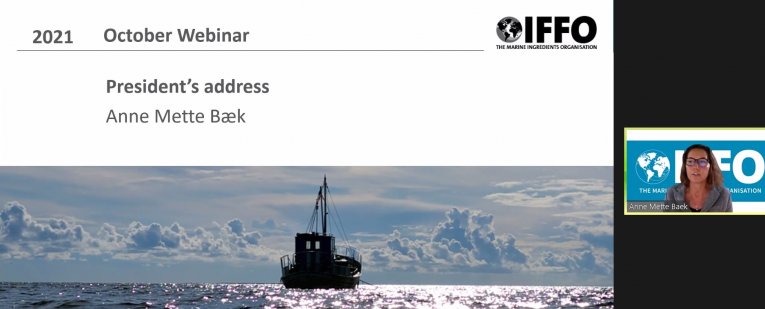 Anne Mette Baek, IFFO’s President, praised the fact that marine ingredients are now being considered in food related discussions. She underlined that “although the complexity of the value chain makes it hard for our industry to be well understood at first sight, there is a clear recognition of marine ingredients’ nutritional value and availability at scale”. At a time when food security is being addressed through the lens of climate change, IFFO wants to provide evidence of its role in mitigating environmental and social impacts, she added.
Anne Mette Baek, IFFO’s President, praised the fact that marine ingredients are now being considered in food related discussions. She underlined that “although the complexity of the value chain makes it hard for our industry to be well understood at first sight, there is a clear recognition of marine ingredients’ nutritional value and availability at scale”. At a time when food security is being addressed through the lens of climate change, IFFO wants to provide evidence of its role in mitigating environmental and social impacts, she added.
Baek stressed that all food production systems generate impacts and it is every industry’s responsibility to mitigate them. A whole life cycle assessment of products is the way forward, she insisted, pointing to actions already taken by the marine ingredients industry, from using by-products to produce fishmeal and fish oil, to reducing emissions when sourcing raw materials. Moreover, impacts of the activity on oceans biomass is monitored and specific programmes exist to reduce by-catch with strict limits and onboard observers.
IFFO’s President announced that IFFO is working on implementing sustainability requirements for its members that go beyond its current code of conduct. Certification programmes and multistakeholder initiatives should be considered as the way forward to address sensitive topic while taking regional approaches into account.
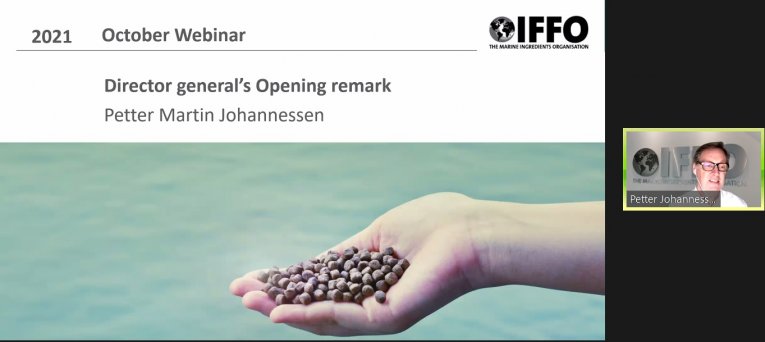 After outlining IFFO’s work over 2021 to provide science-based facts to the value chain and beyond, Petter Johannessen, IFFO’s Director General, addressed the Blue Food Assessment papers published mid September 2021: “We strongly believe that blue foods hold solutions to climate change impacts mitigation. Demand for fish is expected to double by 2050. As fish is a finite resource, we all know that an increased demand is dependent upon aquaculture’s growth”. He then provided an in-depth analysis of the carbon footprint of several raw materials. Relying on Dr Richard Newton (University of Stirling, UK)’s data, he covered fishery materials, by-products resulting from fish processing and grains.
After outlining IFFO’s work over 2021 to provide science-based facts to the value chain and beyond, Petter Johannessen, IFFO’s Director General, addressed the Blue Food Assessment papers published mid September 2021: “We strongly believe that blue foods hold solutions to climate change impacts mitigation. Demand for fish is expected to double by 2050. As fish is a finite resource, we all know that an increased demand is dependent upon aquaculture’s growth”. He then provided an in-depth analysis of the carbon footprint of several raw materials. Relying on Dr Richard Newton (University of Stirling, UK)’s data, he covered fishery materials, by-products resulting from fish processing and grains.
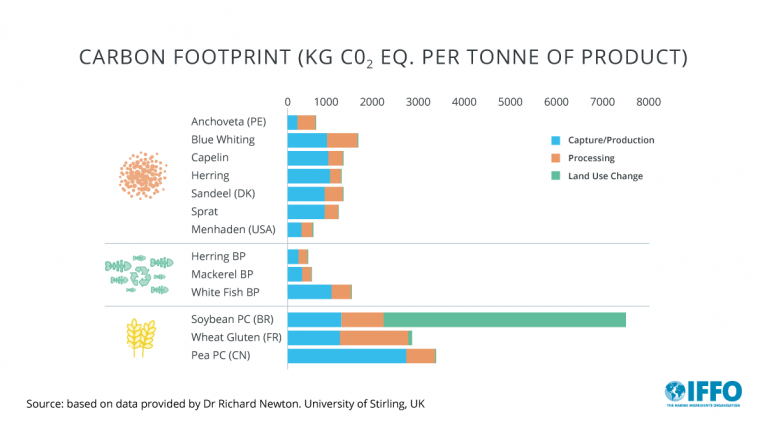
“Combining capture, production and processing of fish meals and oils, it is interesting to note that the carbon footprint of fisheries and byproducts does not suffer from the comparison with that of other materials. Every ingredient sourcing and production generates impacts however this is the case of making them as low as possible.” Land use change is also part of the calculation.
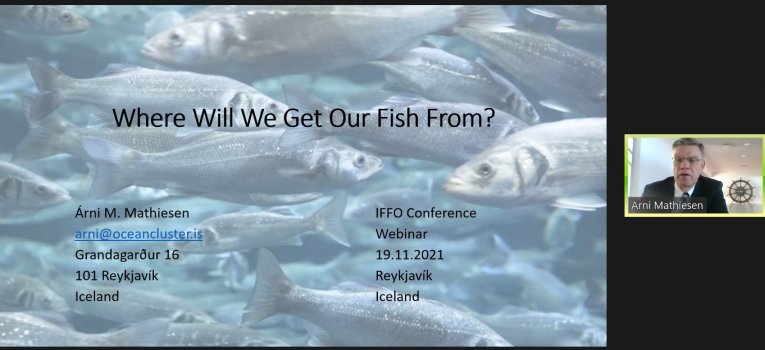 The opening remarks were followed by a keynote speech given by Arni Mathiesen, Independent Chair of the newly launched Global Roundtable on Marine Ingredients, Special Advisor to the Iceland Ocean Cluster and Former Assistant Director General at the FAO.
The opening remarks were followed by a keynote speech given by Arni Mathiesen, Independent Chair of the newly launched Global Roundtable on Marine Ingredients, Special Advisor to the Iceland Ocean Cluster and Former Assistant Director General at the FAO.
“We are facing a potential protein crisis and the role of fish is only going to increase” he started. Wild catch will continue to play a role but there are limits and aquaculture has enabled an increasing production. Aquaculture seems limitless but there are limits in other senses, he added, such as costs, carbon footprint, resource management, knowledge and technology, understanding and consumer preferences, speed and time, plus more.
Land is under greater environmental pressure than sea and there is a need to shift more resources across and investigate new raw materials. “We will be addressing some of these challenges through the Global Roundtable on Marine Ingredients. We will respond to change, technical, economic, social and political. Our role is to help the industry engage and address these changes, through improved resource management and development of new ones; as well as value chain improvement, both technical and socioeconomic. The presumed future activities will be supporting fisheries improvement programmes, initiating research and debate, and initiating value chain development programmes” he explained.
Marine Ingredients and blue food: the 2030 challenge
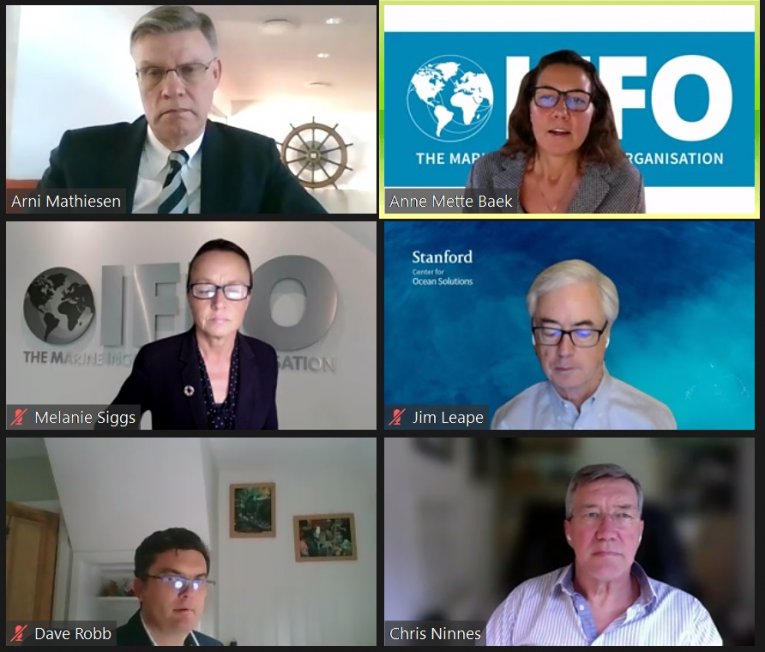 Melanie Siggs, Director at the Global Seafood Alliance, Board Director of The Centre for Responsible Seafood and Global Seafood Assurances, and Advisor to the World Economic Forum’s Ocean Program ‘Friends of Ocean Action’, moderated the panel discussion: “Marine Ingredients and blue food: the 2030 challenge”.
Melanie Siggs, Director at the Global Seafood Alliance, Board Director of The Centre for Responsible Seafood and Global Seafood Assurances, and Advisor to the World Economic Forum’s Ocean Program ‘Friends of Ocean Action’, moderated the panel discussion: “Marine Ingredients and blue food: the 2030 challenge”.
An ocean of opportunities
Anne Mette Bæk, IFFO’s President, kickstarted the discussion, underlining the potential to reshuffle feed sources. With 30% of fishmeal and fish oil currently coming from by-products, there is a clear role for the circular economy mindset even if logistical issues do remain, such as handling the by-products on the vessels and plants to keep the quality high. But with a growing aquaculture sector , getting hold of the by-products is expected to be easier in the future. It is important that all by-products be used, and recognition from certification bodies is needed.
Jim Leape, William and Eva Price Senior Fellow; Co-Director, Centre for Ocean Solutions, Stanford Woods Institute for the Environment, provided some insights on the Blue Food assessment Papers.
“Out of that work we have three important messages: First, blue foods need to be managed as part of the food system, aquaculture needs to be managed as food systems, not just an economic resource. Second, we need to recognise that this sector is very diverse, much more so than land based. Small pelagics are at the top of the chart in turns of richness and nutrients. Finally the role of small farmers, fishers, needs to be recognised. We must extend fishery management, ensuring traceability and transparency. We also need to look careful at environmental trade-offs.”
The key takeaway from Jim Leape’s presentation also relates to the huge diversity of the sector: while a lot of attention is focusing on salmon, shrimp and carp, he explained, there are hundreds of other species, with a huge range in protein and nutrients.
Arni Mathiesen sent a rallying cry for optimism. Opportunities are here, he said, “to relieve pressure on the terrestrial environment, to reduce hunger and malnutrition and to create more value from what we catch”.
Calling for traceability, trust and collaboration
Chris Ninnes, Chief Executive Officer, Aquaculture Stewardship Council (ASC), was also part of the panel as co-chair of a project with the World Economic Forum mapping aquaculture growth and its journey to 2030. “The 2030 aquaculture roadmap is based on the World Bank's initial projection data back in 2013. The intent is to go beyond projections but engage a broad group of stakeholders to look at what are the major types of species around the world and how’s these groups will grow by 2030. We are looking at both the enablers and constraints in species and regions, to help with future policy and investment planning” he explained.
Dave Robb, Sustainability Manager, Cargill Aquaculture Nutrition, underlined the need for resilience. “Climate change is going to affect all our ingredients, there will be increased fluctuations and we therefore need a broad sustainably sourced basket.” he said. Reputation is key also and feed companies need to ensure transparency and trust.
Building coalitions of stakeholders to address IUU, the “pebble in the shoe” was unanimous. Growth comes with responsibilities, all panellists said, and there is a need to engage outside of the sector. The industry can be a valuable voice calling for law enforcement, data collection and sharing in the countries where challenges exist.









